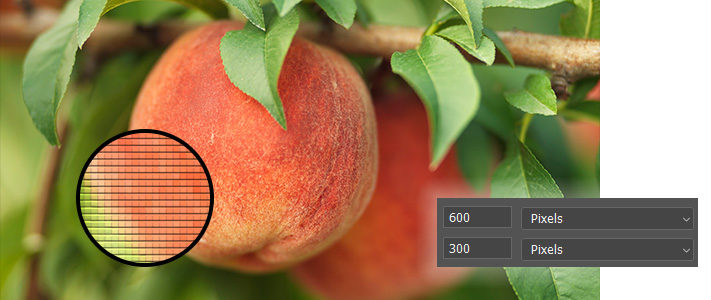Still bored at home during this Civid-19 lockdown? Well then get out those pocket protectors, slide rules and calculators once again because this week we continue our look at understanding height of graphic or text on a display.
In my previous blog post we learned about what size an element (such as a peach) is required to be seen from where my audience stands. We will now tackle a question that pops up during content creation:
- What is a 21-inch size peach on a billboard (example taken in the previous blog), when I’m creating it on a computer screen?
- How big it will be compared to the other elements?
The Canvas is the key
A ‘canvas’ is just as it sounds, is a clean slate of workspace and it is where messages will be created. The canvas is key to creating a message or content for an LED display. Most display specific software and even those of third parties, (Photoshop etc.) require that you open a creation canvas equal to that of the matrix that you are trying to create content for.
Often the canvas is a replication of the actual LED matrix of which you are trying to create content for. So, for example, if the display size is: 300 pixels by 600 pixels, then display physical height, width will be as follows according to the pixel pitch that you have:
- 4 mm pixel pitch: 300 high x 600 wide = 1,200 mm high x 2,400 mm wide
- 6.6 mm pixel pitch: 300 high x 600 wide = 1,980 mm high x 3,960 mm wide
- 8 mm pixel pitch: 300 high x 600 wide = 2,400 mm high x 4,800 mm wide
- 10 mm pixel pitch: 300 high x 600 wide = 3,000 mm high x 6,000 mm wide
- 16mm pixel pitch: 300 high x 600 wide = 4,800 mm high; 8,400 mm wide
This would equate to the total overall height of the display in mm.

Calculating how many pixels will be required
Knowing how many pixels will be required, is (again) a mathematical question. To figure out the size of our graphic for a peach of 21 inches (533.4 mm) high into a matrix such as the ones that you create through your software, we would need to do the following.
- Peach height / pixel pitch = number of pixels height required
- Peach width / pixel pitch = number of pixels width required
If only calculate the height of the peach in two different formats, we get the following answers:
- 4 mm pixel pitch format: 533.4 mm (peach height) / 4 mm pixel pitch = 133 pixels.
- 16 mm pixel pitch format: 533.4 mm / 16 mm pixel pitch = 33 pixels.
This example shows us that we would need to have 133 pixels of the total 300 pixels for a 4 mm pixel pitch and only 33 pixels for 16 mm pixel pitch. Note that the overall height of the peach displayed remains 533 mm or 21 inches in both cases.
In case percentage and ratio better suits you than pixels
If percentage of a surface better suits you, you can also use this quick method of calculation. you better:
- (Peach height / pixel pitch)*100 = percentage of the picture height vs the whole surface
- (Peach width / pixel pitch)*100 = percentage of the picture width vs the whole surface
If only calculate the height of the peach in two different formats, we get the following answers:
Quick method: Ratio calculation.
- 4 mm pixel pitch format: [533.4 (peach height) /1200 mm (4 mm pixel pitch height)]*100 = 44 %
- 16 mm pixel pitch format: [533.4(peach height) /4,800mm pixel pitch height)]*100 = 11%
Essentially in the examples above the one could estimate the size of the graphic on the canvas would be about 44% and in the second case 11% the total height of the canvas.
Coming soon to a blog near you; More Math & Display ratio sizes
Multiple LED displays often with multiple matrices and physical sizes pose one single problem when it comes to content creation. Is multiple messages or content pieces required for the same message? If care and thought is put into the deployment before hand, one will be able to reduce the overall costs and effort to deploy content over networked LED displays. However, more on that in the next Blog.
Please let me know if you have any questions or comments with these blogs or if you feel that a particular issue should be addressed. I will do my best to cover it in the coming blogs.
On a serious note
I really hope that you are all doing well during this time and staying safe and healthy. Weather working from home, or taking care of your children, family and neighbours, let’s all do our part to get over this period.

